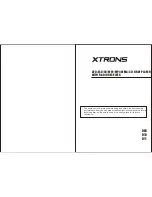
9. GLOSSARY
32
VT1010E
9. GLOSSARY
Active matrix:
A flat panel display technology that produces a brighter and sharper display
and a broader viewing angle than passive matrix panels. Each pixel has its own thin film
transistor (TFT) and is sometimes called a
“
TFT screen.
”
Aspect ratio:
The comparison of the width to the height of an object.
Audio/video (A/V) source:
Any additional audio and/or video device that has a composite
RCA output, such as a game player, VCR, digital camera, etc.
CD:
Compact Disc.
CD-R/RW:
CD Read/Read and Write.
Display angle:
The extent to which the LCD screen can be opened (150 degrees).
Dolby Digital:
The marketing name for the audio compression technologies developed by
Dolby Laboratories.
DVD:
Digital Video Disc or Digital Versatile Disc.
DVD-R:
DVD Read only.
DVD-RW:
DVD Read and Write.
JPEG/JPG:
Joint Pictures Expert Group, the committee that developed the standards for
compressing graphics, especially photographs.
IR:
Infrared.
NTSC:
National TV Standards Committee, the group that developed the television
standards used in the United States.
LCD:
Liquid Crystal Display, the technology used for laptop and other small computer
monitors.
MP3:
MPEG Audio Layer-3, a standard for sound compression without sacrificing quality.
OSD:
on-screen display.
PAL:
The primarily European standard for displaying analog television signals.
Pixel:
Short for picture element, the smallest point on a graphic image or monitor.
TFT (Thin film transistor):
The display technology in which thin films are deposited during
the manufacturing process to create metallic contacts.
SRC:
Source.
VCD:
Video CD, the standard for storing video on a CD.
Viewing angle:
Pre-recorded alternative angles for individual scenes.
WVGA:
Wide Angle Video Array, the number of pixels in each direction that can be
displayed on a monitor.


































